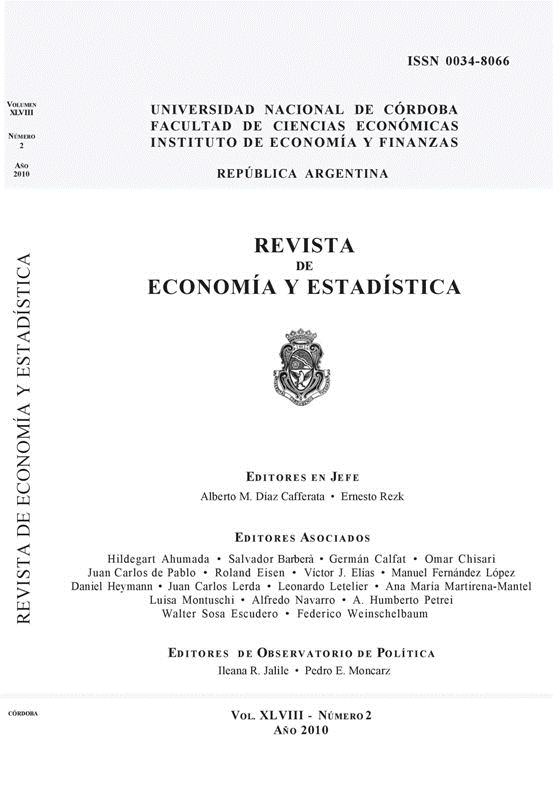Fiscal Multipliers in the Euro Area
DOI:
https://doi.org/10.55444/2451.7321.2010.v48.n2.4105Keywords:
euro area , SVAR , fiscal shocks, fiscal multipliersAbstract
In a standard linear structural VAR framework we analyse the size and signof fi scal multipliers in the euro area, using a newly available quarterly datasetof fi scal variables for the period 1981-2007. From a policy perspective,the analysis of fi scal multipliers in “average times” provides insights on theimpact of both fi scal stimulus and fi scal consolidation measures, provided“good” and “bad” times are on average similar.
Downloads
References
Afonso, A. and R. M. Sousa (2009a). “The macroeconomic effects of fiscal policy”. ECB Working Paper Series No. 991, January.
Afonso, A. and R. M. Sousa (2009b). “The macroeconomic effects of fiscal policy in Portugal: a Bayesian SVAR analysis”. School of Economics and Management, Working Papers Nº 09/2009/DE/UECE.
Bénassy-Quéré, A. and J. Cimadomo (2006). “Changing patterns of domestic and cross-border fiscal policy multipliers in Europe and the US”. CEPII WP #2006-24.
Beetsma, R. and M. Giuliodori (2009). “Discretionary fiscal policy: review and estimates for the EU”. Mimeo.
Blanchard, O. J. and R. Perotti (2002). “An Empirical Characterization of the Dynamic Effects of Changes in Government Spending and Taxes on Output”. Quarterly Journal of Economics, 117, pp. 1329-1368.
Bouthevillain, C., Cour-Thimann, P., van den Dool, G., Hernández de Cos, P., Langenus, G., Mohr, M., Momigliano, S., Tujula, M., 2001. “Cyclically adjusted budget balances: An alternative approach”. ECB Working Paper Series No. 77.
Burriel, P., de Castro, F., Garrote, D., Gordo, E., Paredes, J., Pérez, J., 2010. “Fiscal Policy shocks in the Euro Area and the US: an empirical assessment”, Fiscal Studies, 31(2), pp. 251-285.
Caldara, D. and C. Kamps (2008). “What are the effects of fiscal policy shocks? A VAR-based comparative analysis”. ECB Working Paper Series No. 877, March.
Cogan, J., T. Cwik, J.B. Taylor and V. Wieland (2009). “New Keynesian versus Old Keynesian Government Spending Multipliers”. CEPR Discussion Paper 7236, March.
Christoffel, K., G. Coenen and A. Warne (2008). “The New Area-Wide Model of the euro area: a micro-founded open-economy model for forecasting and policy analysis”. ECB Working Paper Series No 944, October.
Cwik, T. and V. Wieland, (2009). “Keynesian government spending multipliers and spillovers in the Eurozone”. CEPR Discussion Paper 7389, August.
de Castro, F. (2006). “The macroeconomic effects of fiscal policy in Spain”. Applied Economics, 38, pp. 913-924.
de Castro, F and P. Hernández de Cos (2008). “The economic effects of fiscal policy: the case of Spain. Journal of Macroeconomics”, 30, pp. 1005-1028.
Fatás, A. and I. Mihov (2001). “The effects of fiscal policy on consumption and employment: theory and evidence”. CEPR Discussion Paper Series No. 2760.
Fagan, G., J. Henry and R. Mestre (2005). “An area-wide model (AWM) for the euro area. Economic Modelling”, 22, pp. 39-59.
Favero, C, and F. Giavazzi (2007). “Debt and the effects of fiscal policies”. NBER Working Paper Series No. 12822.
Giordano, R., S. Momigliano, S. Neri and R. Perotti (2007). “The effects of fiscal policy in Italy: Evidence from a VAR model”. European Journal of Political Economy, 23, pp. 707–733.
Giorno, C., P. Richardson, D. Roseveare and P. van den Noord (1995). “Potential output, output gaps and structural budget balances”. OECD Economic Studies 24.
Golinelli, R. and S. Momigliano (2009). “The cyclical reaction of fiscal policies in the euro area: the role of modelling choices and data vintages”. Fiscal Studies, 30, pp. 39-72.
Gómez, V. and A. Maravall (1996). “Programs TRAMO (Time series Regression with ARIMA noise, Missing observations, and Outliers) and SEATS (Signal Extraction in ARIMA Time Series). Instructions for the User”. Working Paper 9628, Banco de España.
Heppke-Falk, K.H., J. Tenhofen and G.B. Wolff (2006). “The macroeconomic effects of exogenous fiscal policy shocks in Germany: a disaggregated SVAR analysis”. Deutsche Bundesbank. Discussion Paper Series 1: Economic Studies No 41/2006.
Jacobs, J. P. A. M., G. H. Kuper and J. Verlinden (2007). “Monetary policy in the euro area: the impact of fiscal closure rules”. Working Paper 2007/01, Institute of Economics and Econometrics, University of Groningen.
Laubach, T. (2009). “New evidence on the interest rate effects of budget deficits and debt”. Journal of the European Economic Association, 7(4), pp. 858–885.
Leeper, E.M.. T.B. Walker and S.S. Yang (2008). “Fiscal foresight: analytics and econometrics”. NBER Working Paper Series No. 14028.
Marcellino, M. (2006). “Some stylized facts on non-systematic fiscal policy in the euro area”. Journal of Macroeconomics, 28, pp. 461-479.
Mountford, A. and H. Uhlig (2009). “What are the effects of fiscal policy shocks?” Forthcoming in the Journal of Applied Econometrics.
Neri, S. (2001). “Assessing the effects of monetary and fiscal policy”. Banca d’Italia Discussion Papers No. 425.
Paredes, J., D. J. Pedregal and J. J. Pérez (2009). “A quarterly fiscal database for the euro area based on intra-annual fiscal indicators”. ECB Working Paper Series, forthcoming.
Perotti, R. (2004). “Estimating the effects of fiscal policy in OECD countries”. Proceedings, Federal Reserve Bank of San Francisco.
Ramey, V. (2007). Comment on "In search of the transmission mechanism of fiscal policy". In: NBER Macroeconomics Annual 2007, Volume 22.
Ratto, M., W. Roeger, and J. in’t Veld (2009). “Quest III, An estimated open-economy DSGE model of the Eurozone with fiscal and monetary policy”. Economic Modelling, 26, pp. 222-233.
Smets, F. and R. Wouters (2003). “An estimated dynamic stochastic general equilibrium model of the euro area”. Journal of the European Economic Association, 1, pp. 1123-1175.
Smets, F. and R. Wouters (2005). “Comparing shocks and frictions in US and euro area business cycles: a Bayesian DSGE approach”. Journal of Applied Econometrics, 20, pp. 161-183.
van den Noord, P. (2000). “The size and role of automatic fiscal stabilizers in the 1990s and beyond”. OECD Working Paper No. 230.
Yang, S.-C.S. (2005). “Quantifying tax effects under policy foresight”. Journal of Monetary Economics, 52(8), pp. 1557-1568.
Yang, S.-C.S. (2007). “Tentative evidence of tax foresight”. Economics Letters, 96, pp 30-37.
Downloads
Published
How to Cite
Issue
Section
License
Copyright (c) 2010 Pablo Burriel, Francisco de Castro, Daniel Garrote, Esther Gordo, Joan Paredes, Javier J. Pérez

This work is licensed under a Creative Commons Attribution-NonCommercial-NoDerivatives 4.0 International License.
Authors who have publications with this journal agree to the following terms:
Authors retain their copyright and grant the journal the right of first publication of their work, which is simultaneously subject to the Creative Commons Attribution-NonCommercial-NoDerivatives 4.0 International License that allows third parties to share the work provided that its author and first publication in this journal are indicated.
Authors may adopt other non-exclusive licensing arrangements for distribution of the published version of the work (e.g. depositing it in an institutional telematic archive or publishing it in a monographic volume) as long as the initial publication in this journal is indicated.
Authors are allowed and encouraged to disseminate their work via the Internet (e.g. in institutional telematic archives or on their website) before and during the submission process, which can lead to interesting exchanges and increase citations of the published work. (See The Open Access Effect)









